High-Throughput Identification and Prediction of Early Stress Markers in Soybean Under Progressive Water Regimes via Hyperspectral Spectroscopy and Machine Learning
Highlights
- Hyperspectral spectroscopy combined with machine learning enables high-accuracy, nondestructive prediction of early stress markers (pigments, osmolytes, antioxidants, cell wall compounds, and water status) in soybean under progressive drought via remote sensing and machine learning models.
- Tree-based ensemble and neural network models (e.g., random forest, MLP) achieved >95% accuracy in classifying drought severity, outperformed distance- and probability-based classifiers, and effectively distinguished eleven water regimes across the full or range UV–VIS–NIR–SWIR spectrum.
- The integration of hyperspectral sensors and machine learning provides a rapid, field-deployable solution for early drought detection and precision irrigation management in soybean, potentially reducing the reliance on time-consuming laboratory assays via remote sensing tools.
- Selecting minimal and informative spectral bands paves the way for simplified, cost-effective proximal or UAV-mounted sensors for large-scale drought phenotyping and smart agriculture applications.
Abstract
1. Introduction
2. Material and Methods
2.1. Plant Materials
2.2. Hyperspectral Reflectance Data
2.3. Chlorophylls and Carotenoids Extraction
2.3.1. Quantification of Chlorophylls and Carotenoids
2.3.2. Quantification of Flavonoids
2.4. Quantification of Proline
2.5. Quantification of Soluble Phenolic Compounds (Phe)
2.6. Preparation of Protein-Free Cell Wall Fraction (PFCW) and Quantification of Lignin and Cellulose
2.6.1. Lignin Content Determination
2.6.2. Cellulose Content Determination
2.7. Antioxidant Activity (RSA%)
2.8. Electrolyte Leakage (ELK%)
2.9. Relative Water Content (RWC%)
2.10. Statistical Analyses
2.10.1. Analysis of Variance and Descriptive Statistics
2.10.2. Principal Component Analyses (PCA)
2.10.3. Vegetation Indices (VIs)
2.10.4. Hierarchical and Cluster Analysis
2.10.5. Machine Learning Models
2.10.6. Correlation and Heatmap Analyses
2.10.7. Selection of Responsive Spectral Bands
2.10.8. Partial Least Squares Regression (PLSR)
2.10.9. Analysis of Optimized Hyperspectral Vegetation Indices
3. Results
3.1. Photosynthetic and Protective Pigments, Stress Markers, and Leaf Biochemical Parameters
3.2. Spectral Reflectance Profiles Under Water Regimes
3.3. Principal Component Analysis of Leaf Reflectance
3.4. Variable Importance of Vegetation Indices for Leaf Trait Prediction
3.5. Hierarchical Clustering of Spectral Profiles Under Water Regimes
3.6. Correlation Between Spectral Data and Leaf Biochemical/Biophysical Traits
3.7. Wavelength Selection for the Prediction and Classification of Leaf Traits
3.8. Predictive Modelling Using Hyperspectral Reflectance
3.9. Identification of the Most Responsive Wavelength Pairs via Spectral Correlation Analysis
4. Discussion
4.1. Overview of Key Findings
4.2. Principal Component Analysis and Model Performance
4.3. Correlation Analysis and Implications for Spectral Indices
4.4. Wavelength Selection for Predictive Modelling
5. Conclusions
Author Contributions
Funding
Institutional Review Board Statement
Informed Consent Statement
Data Availability Statement
Acknowledgments
Conflicts of Interest
References
- dos Santos, G.L.A.A.; Reis, A.S.; Besen, M.R.; Furlanetto, R.H.; Rodrigues, M.; Crusiol, L.G.T.; de Oliveira, K.M.; Falcioni, R.; de Oliveira, R.B.; Batista, M.A.; et al. Spectral Method for Macro and Micronutrient Prediction in Soybean Leaves Using Interval Partial Least Squares Regression. Eur. J. Agron. 2023, 143, 126717. [Google Scholar] [CrossRef]
- Crusiol, L.G.T.; Nanni, M.R.; Furlanetto, R.H.; Sibaldelli, R.N.R.; Sun, L.; Gonçalves, S.L.; Foloni, J.S.S.; Mertz-Henning, L.M.; Nepomuceno, A.L.; Neumaier, N.; et al. Assessing the Sensitive Spectral Bands for Soybean Water Status Monitoring and Soil Moisture Prediction Using Leaf-Based Hyperspectral Reflectance. Agric. Water Manag. 2023, 277, 108089. [Google Scholar] [CrossRef]
- Vargas-Almendra, A.; Ruiz-Medrano, R.; Núñez-Muñoz, L.A.; Ramírez-Pool, J.A.; Calderón-Pérez, B.; Xoconostle-Cázares, B. Advances in Soybean Genetic Improvement. Plants 2024, 13, 3073. [Google Scholar] [CrossRef]
- Yoosefzadeh-Najafabadi, M.; Tulpan, D.; Eskandari, M. Using Hybrid Artificial Intelligence and Evolutionary Optimization Algorithms for Estimating Soybean Yield and Fresh Biomass Using Hyperspectral Vegetation Indices. Remote Sens. 2021, 13, 2555. [Google Scholar] [CrossRef]
- Flexas, J.; Medrano, H. Drought-Inhibition of Photosynthesis in C3plants: Stomatal and Non-Stomatal Limitations Revisited. Ann. Bot. 2002, 89, 183–189. [Google Scholar] [CrossRef]
- Chaudhry, S.; Sidhu, G.P.S. Climate Change Regulated Abiotic Stress Mechanisms in Plants: A Comprehensive Review. Plant Cell Rep. 2022, 41, 1–31. [Google Scholar] [CrossRef]
- Wang, Q.; Zuo, Z.; Wang, X.; Gu, L.; Yoshizumi, T.; Yang, Z.; Yang, L.; Liu, Q.; Liu, W.; Han, Y.-J.; et al. Photoactivation and Inactivation of in Arabidopsis Cryptochrome 2. Science 2016, 354, 343–347. [Google Scholar] [CrossRef] [PubMed]
- Shurygin, B.; Chivkunova, O.; Solovchenko, O.; Solovchenko, A.; Dorokhov, A.; Smirnov, I.; Astashev, M.E.; Khort, D. Comparison of the Non-Invasive Monitoring of Fresh-Cut Lettuce Condition with Imaging Reflectance Hyperspectrometer and Imaging PAM-Fluorimeter. Photonics 2021, 8, 425. [Google Scholar] [CrossRef]
- Nievola, C.C.; Carvalho, C.P.; Carvalho, V.; Rodrigues, E. Rapid Responses of Plants to Temperature Changes. Temperature 2017, 4, 371–405. [Google Scholar] [CrossRef]
- Falcioni, R.; Gonçalves, J.V.F.; de Oliveira, K.M.; de Oliveira, C.A.; Reis, A.S.; Crusiol, L.G.T.; Furlanetto, R.H.; Antunes, W.C.; Cezar, E.; de Oliveira, R.B.; et al. Chemometric Analysis for the Prediction of Biochemical Compounds in Leaves Using UV-VIS-NIR-SWIR Hyperspectroscopy. Plants 2023, 12, 3424. [Google Scholar] [CrossRef]
- Falcioni, R.; de Oliveira, C.A.; Vedana, N.G.; Mendonça, W.A.; Gonçalves, J.V.F.; da Silva Haubert, D.D.F.; de Matos, D.H.S.; Reis, A.S.; Antunes, W.C.; Crusiol, L.G.T.; et al. Progressive Water Deficit Impairs Soybean Growth, Alters Metabolic Profiles, and Decreases Photosynthetic Efficiency. Plants 2025, 14, 2615. [Google Scholar] [CrossRef] [PubMed]
- Falcioni, R.; de Oliveira, R.B.; Chicati, M.L.; Antunes, W.C.; Demattê, J.A.M.; Nanni, M.R. Fluorescence and Hyperspectral Sensors for Nondestructive Analysis and Prediction of Biophysical Compounds in the Green and Purple Leaves of Tradescantia Plants. Sensors 2024, 24, 6490. [Google Scholar] [CrossRef] [PubMed]
- Hassanzadeh, A.; Murphy, S.P.; Pethybridge, S.J.; van Aardt, J. Growth Stage Classification and Harvest Scheduling of Snap Bean Using Hyperspectral Sensing: A Greenhouse Study. Remote Sens. 2020, 12, 3809. [Google Scholar] [CrossRef]
- Buchhorn, M.; Raynolds, M.K.; Walker, D.A. Influence of BRDF on NDVI and Biomass Estimations of Alaska Arctic Tundra. Environ. Res. Lett. 2016, 11, 1–13. [Google Scholar] [CrossRef]
- Chaves, M.E.D.; De Carvalho Alves, M.; De Oliveira, M.S.; Sáfadi, T. A Geostatistical Approach for Modeling Soybean Crop Area and Yield Based on Census and Remote Sensing Data. Remote Sens. 2018, 10, 680. [Google Scholar] [CrossRef]
- Sims, D.A.; Gamon, J.A. Relationships between Leaf Pigment Content and Spectral Reflectance across a Wide Range of Species, Leaf Structures and Developmental Stages. Remote Sens. Environ. 2002, 81, 337–354. [Google Scholar] [CrossRef]
- Jia, M.; Li, D.; Colombo, R.; Wang, Y.; Wang, X.; Cheng, T.; Zhu, Y.; Yao, X.; Xu, C.; Ouer, G.; et al. Quantifying Chlorophyll Fluorescence Parameters from Hyperspectral Reflectance at the Leaf Scale under Various Nitrogen Treatment Regimes in Winter Wheat. Remote Sens. 2019, 11, 2838. [Google Scholar]
- Ryu, J.H.; Jeong, H.; Cho, J. Performances of Vegetation Indices on Paddy Rice at Elevated Air Temperature, Heat Stress, and Herbicide Damage. Remote Sens. 2020, 12, 2654. [Google Scholar] [CrossRef]
- Li, K.; Wang, C.; Rong, G.; Wei, S.; Liu, C.; Yang, Y.; Sudu, B.; Guo, Y.; Sun, Q.; Zhang, J. Dynamic Evaluation of Agricultural Drought Hazard in Northeast China Based on Coupled Multi-Source Data. Remote Sens. 2023, 15, 57. [Google Scholar] [CrossRef]
- Sobejano-Paz, V.; Mikkelsen, T.N.; Baum, A.; Mo, X.; Liu, S.; Köppl, C.J.; Johnson, M.S.; Gulyas, L.; García, M. Hyperspectral and Thermal Sensing of Stomatal Conductance, Transpiration, and Photosynthesis for Soybean and Maize under Drought. Remote Sens. 2020, 12, 3182. [Google Scholar] [CrossRef]
- Osman, S.O.M.; Saad, A.S.I.; Tadano, S.; Takeda, Y.; Konaka, T.; Yamasaki, Y.; Tahir, I.S.A.; Tsujimoto, H.; Akashi, K. Chemical Fingerprinting of Heat Stress Responses in the Leaves of Common Wheat by Fourier Transform Infrared Spectroscopy. Int. J. Mol. Sci. 2022, 23, 2842. [Google Scholar] [CrossRef]
- Crusiol, L.G.T.; Sun, L.; Sun, Z.; Chen, R.; Wu, Y.; Ma, J.; Song, C. In-Season Monitoring of Maize Leaf Water Content Using Ground-Based and UAV-Based Hyperspectral Data. Sustainability 2022, 14, 9039. [Google Scholar] [CrossRef]
- da Silva Junior, C.A.; Nanni, M.R.; Shakir, M.; Teodoro, P.E.; de Oliveira-Júnior, J.F.; Cezar, E.; de Gois, G.; Lima, M.; Wojciechowski, J.C.; Shiratsuchi, L.S. Soybean Varieties Discrimination Using Non-Imaging Hyperspectral Sensor. Infrared Phys. Technol. 2018, 89, 338–350. [Google Scholar] [CrossRef]
- Baio, F.H.R.; Santana, D.C.; Teodoro, L.P.R.; de Oliveira, I.C.; Gava, R.; de Oliveira, J.L.G.; da Silva Junior, C.A.; Teodoro, P.E.; Shiratsuchi, L.S. Maize Yield Prediction with Machine Learning, Spectral Variables and Irrigation Management. Remote Sens. 2023, 15, 79. [Google Scholar]
- Vian, C.E.D.F.; Andrade Júnior, A.M.; Baricelo, L.G.; Da Silva, R.P. Origens, Evolução e Tendências Da Indústria de Máquinas Agrícolas. Rev. Econ. e Sociol. Rural 2013, 51, 719–744. [Google Scholar][Green Version]
- Sonobe, R.; Wang, Q. Hyperspectral Indices for Quantifying Leaf Chlorophyll Concentrations Performed Differently with Different Leaf Types in Deciduous Forests. Ecol. Inform. 2017, 37, 1–9. [Google Scholar][Green Version]
- Braga, P.; Crusiol, L.G.T.; Nanni, M.R.; Caranhato, A.L.H.; Fuhrmann, M.B.; Nepomuceno, A.L.; Neumaier, N.; Farias, J.R.B.; Koltun, A.; Gonçalves, L.S.A.; et al. Vegetation Indices and NIR-SWIR Spectral Bands as a Phenotyping Tool for Water Status Determination in Soybean. Precis. Agric. 2021, 22, 249–266. [Google Scholar][Green Version]
- Mondal, S.; Karmakar, S.; Panda, D.; Pramanik, K.; Bose, B.; Singhal, R.K. Crucial Plant Processes under Heat Stress and Tolerance through Heat Shock Proteins. Plant Stress 2023, 10, 100227. [Google Scholar] [CrossRef]
- Galvão, L.S.; Formaggio, A.R.; Tisot, D.A. Discrimination of Sugarcane Varieties in Southeastern Brazil with EO-1 Hyperion Data. Remote Sens. Environ. 2005, 94, 523–534. [Google Scholar] [CrossRef]
- Kováč, D.; Veselovská, P.; Klem, K.; Večeřová, K.; Ač, A.; Peñuelas, J.; Urban, O. Potential of Photochemical Reflectance Index for Indicating Photochemistry and Light Use Efficiency in Leaves of European Beech and Norway Spruce Trees. Remote Sens. 2018, 10, 1202. [Google Scholar]
- de Oliveira, K.M.; Ferreira Gonçalves, J.V.; Falcioni, R.; Almeida de Oliveira, C.; de Fatima da Silva Haubert, D.; Mendonça, W.A.; Teixeira Crusiol, L.G.; Berti de Oliveira, R.; Reis, A.S.; Cezar, E.; et al. Classification of Soil Horizons Based on VisNIR and SWIR Hyperespectral Images and Machine Learning Models. Remote Sens. Appl. Soc. Environ. 2024, 36, 101362. [Google Scholar] [CrossRef]
- Sexton, T.; Sankaran, S.; Cousins, A.B. Predicting Photosynthetic Capacity in Tobacco Using Shortwave Infrared Spectral Reflectance. J. Exp. Bot. 2021, 72, 4373–4383. [Google Scholar] [CrossRef] [PubMed]
- Falcioni, R.; de Oliveira, R.B.; Chicati, M.L.; Antunes, W.C.; Demattê, J.A.M.; Nanni, M.R. Estimation of Biochemical Compounds in Tradescantia Leaves Using VIS-NIR-SWIR Hyperspectral and Chlorophyll a Fluorescence Sensors. Remote Sens. 2024, 16, 1910. [Google Scholar]
- Crusiol, L.G.T.; Sun, L.; Sibaldelli, R.N.R.; Junior, V.F.; Furlaneti, W.X.; Chen, R.; Sun, Z.; Wuyun, D.; Chen, Z.; Nanni, M.R.; et al. Strategies for Monitoring Within-Field Soybean Yield Using Sentinel-2 Vis-NIR-SWIR Spectral Bands and Machine Learning Regression Methods. Precis. Agric. 2022, 23, 1093–1123. [Google Scholar]
- Falcioni, R.; Gonçalves, J.V.F.; de Oliveira, K.M.; Antunes, W.C.; Nanni, M.R. VIS-NIR-SWIR Hyperspectroscopy Combined with Data Mining and Machine Learning for Classification of Predicted Chemometrics of Green Lettuce. Remote Sens. 2022, 14, 6330. [Google Scholar] [CrossRef]
- Gitelson, A.; Solovchenko, A. Non-Invasive Quantification of Foliar Pigments: Possibilities and Limitations of Reflectance- and Absorbance-Based Approaches. J. Photochem. Photobiol. B Biol. 2018, 178, 537–544. [Google Scholar]
- Falcioni, R.; Moriwaki, T.; Gibin, M.S.; Vollmann, A.; Pattaro, M.C.; Giacomelli, M.E.; Sato, F.; Nanni, M.R.; Antunes, W.C. Classification and Prediction by Pigment Content in Lettuce (Lactuca sativa L.) Varieties Using Machine Learning and ATR-FTIR Spectroscopy. Plants 2022, 11, 3413. [Google Scholar] [CrossRef]
- Ragaee, S. Antioxidant Activity and Nutrient Composition of Selected Cereals for Food Use. Food Chem. 2006, 98, 32–38. [Google Scholar] [CrossRef]
- Izenman, A.J. Modern Multivariate Statistical Techniques, 1st ed.; Springer: Berlin/Heidelberg, Germany, 2008. [Google Scholar]
- Carlson, T.N.; Ripley, D.A. On the Relation between NDVI, Fractional Vegetation Cover, and Leaf Area Index. Remote Sens. Environ. 1997, 62, 241–252. [Google Scholar] [CrossRef]
- Gitelson, A.A.; Kaufman, Y.J.; Merzlyak, M.N. Use of a Green Channel in Remote Sensing of Global Vegetation from EOS-MODIS. Remote Sens. Environ. 1996, 58, 289–298. [Google Scholar]
- Ahamed, T.; Tian, L.; Zhang, Y.; Ting, K.C. A Review of Remote Sensing Methods for Biomass Feedstock Production. Biomass and Bioenergy 2011, 35, 2455–2469. [Google Scholar] [CrossRef]
- Bannari, A.; Morin, D.; Bonn, F.; Huete, A.R. A Review of Vegetation Indices. Remote Sens. Rev. 1995, 13, 95–120. [Google Scholar] [CrossRef]
- Blackburn, G.A. Spectral Indices for Estimating Photosynthetic Pigment Concentrations: A Test Using Senescent Tree Leaves. Int. J. Remote Sens. 1998, 19, 657–675. [Google Scholar] [CrossRef]
- Falcioni, R.; Antunes, W.C.; Demattê, J.A.M.; Nanni, M.R. Biophysical, Biochemical, and Photochemical Analyses Using Reflectance Hyperspectroscopy and Chlorophyll a Fluorescence Kinetics in Variegated Leaves. Biology 2023, 12, 704. [Google Scholar] [CrossRef]
- Peñuelas, J.; Gamon, J.A.; Fredeen, A.L.; Merino, J.; Field, C.B. Reflectance Indices Associated with Physiological Changes in Nitrogen- and Water-Limited Sunflower Leaves. Remote Sens. Environ. 1994, 48, 135–146. [Google Scholar] [CrossRef]
- Hunt, E.R.; Rock, B.N. Detection of Changes in Leaf Water Content Using Near- and Middle-Infrared Reflectances. Remote Sens. Environ. 1989, 30, 43–54. [Google Scholar]
- Cibula, W.G.; Zetka, E.F.; Rickman, D.L. Response of Thematic Mapper Bands to Plant Water Stress. Int. J. Remote Sens. 1992, 13, 1869–1880. [Google Scholar] [CrossRef]
- Patil, P.P.; Jagtap, M.P.; Khatri, N.; Madan, H.; Vadduri, A.A.; Patodia, T. Exploration and Advancement of NDDI Leveraging NDVI and NDWI in Indian Semi-Arid Regions: A Remote Sensing-Based Study. Case Stud. Chem. Environ. Eng. 2024, 9, 100573. [Google Scholar]
- Staszel, J.; Lupa, M.; Adamek, K.; Wilkosz, M.; Marcinkowska-Ochtyra, A.; Ochtyra, A. Spatial Insights into Drought Severity: Multi-Index Assessment in Małopolska, Poland, via Satellite Observations. Remote Sens. 2024, 16, 836. [Google Scholar] [CrossRef]
- Gitelson, A.A.; Zur, Y.; Chivkunova, O.B.; Merzlyak, M.N. Assessing Carotenoid Content in Plant Leaves with Reflectance Spectroscopy. Photochem. Photobiol. 2002, 75, 272. [Google Scholar] [CrossRef]
- Vogelmann, J.E.; Rock, B.N.; Moss, D.M. Red Edge Spectral Measurements from Sugar Maple Leaves. Int. J. Remote Sens. 1993, 14, 1563–1575. [Google Scholar] [CrossRef]
- Peñuelas, J.; Filella, I. Visible and Near-Infrared Reflectance Techniques for Diagnosing Plant Physiological Status. Trends Plant Sci. 1998, 3, 151–156. [Google Scholar] [CrossRef]
- Peñuelas, J.; Filella, I.; Gamon, J.A. Assessment of Photosynthetic Radiation-Use Efficiency with Spectral Reflectance. New Phytol. 1995, 131, 291–296. [Google Scholar] [CrossRef]
- Zheng, W.; Lu, X.; Li, Y.; Li, S.; Zhang, Y. Hyperspectral Identification of Chlorophyll Fluorescence Parameters of Suaeda Salsa in Coastal Wetlands. Remote Sens. 2021, 13, 2066. [Google Scholar] [CrossRef]
- Barnes, M.L.; Breshears, D.D.; Law, D.J.; van Leeuwen, W.J.D.; Monson, R.K.; Fojtik, A.C.; Barron-Gafford, G.A.; Moore, D.J.P. Beyond Greenness: Detecting Temporal Changes in Photosynthetic Capacity with Hyperspectral Reflectance Data. PLoS ONE 2017, 12, e0189539. [Google Scholar] [CrossRef]
- Nehra, A.; Kalwan, G.; Taneja, D.; Jangra, R.; Joshi, K.; Kumar, A.; Jain, P.K.; Nehra, K.; Ansari, M.W.; Singh, K.; et al. Comprehensive Structural, Evolutionary and Functional Analysis of Superoxide Dismutase Gene Family Revealed Critical Role in Salinity and Drought Stress Responses in Chickpea (Cicer arietinum L.). Plant Physiol. Biochem. 2025, 226, 110042. [Google Scholar] [CrossRef] [PubMed]
- Valentini, R.; Epron, D.; De Angelis, P.; Matteucci, G.; Dreyer, E. In Situ Estimation of Net CO2 Assimilation, Photosynthetic Electron Flow and Photorespiration in Turkey Oak (Q. cerris L.) Leaves: Diurnal Cycles under Different Levels of Water Supply. Plant. Cell Environ. 1995, 18, 631–640. [Google Scholar] [CrossRef]
- Gill, S.S.; Tuteja, N. Reactive Oxygen Species and Antioxidant Machinery in Abiotic Stress Tolerance in Crop Plants. Plant Physiol. Biochem. 2010, 48, 909–930. [Google Scholar] [CrossRef]
- Zhou, Y.H.; Zhang, Y.Y.; Zhao, X.; Yu, H.J.; Shi, K.; Yu, J.Q. Impact of Light Variation on Development of Photoprotection, Antioxidants, and Nutritional Value in Lactuca sativa L. J. Agric. Food Chem. 2009, 57, 5494–5500. [Google Scholar] [CrossRef]
- Pinnola, A.; Bassi, R. Molecular Mechanisms Involved in Plant Photoprotection. Biochem. Soc. Trans. 2018, 46, 467–482. [Google Scholar] [CrossRef]
- Gitelson, A.; Chivkunova, O.; Zhigalova, T.; Solovchenko, A. In Situ Optical Properties of Foliar Flavonoids: Implication for Non-Destructive Estimation of Flavonoid Content. J. Plant Physiol. 2017, 218, 258–264. [Google Scholar] [CrossRef]
- Hichri, I.; Barrieu, F.; Bogs, J.; Kappel, C.; Delrot, S.; Lauvergeat, V. Recent Advances in the Transcriptional Regulation of the Flavonoid Biosynthetic Pathway. J. Exp. Bot. 2011, 62, 2465–2483. [Google Scholar] [CrossRef]
- Zhou, Z.; Gao, H.; Ming, J.; Ding, Z.; Lin, X.; Zhan, R. Combined Transcriptome and Metabolome Analysis of Pitaya Fruit Unveiled the Mechanisms Underlying Peel and Pulp Color Formation. BMC Genomics 2020, 21, 734. [Google Scholar] [CrossRef]
- Baranović, G.; Šegota, S. Infrared Spectroscopy of Flavones and Flavonols. Reexamination of the Hydroxyl and Carbonyl Vibrations in Relation to the Interactions of Flavonoids with Membrane Lipids. Spectrochim. Acta Part A Mol. Biomol. Spectrosc. 2018, 192, 473–486. [Google Scholar] [CrossRef]
- Almakas, A.; Elrys, A.S.; Desoky, E.-S.M.; Al-Shuraym, L.A.; Alhag, S.K.; Alshaharni, M.O.; Alnadari, F.; NanNan, Z.; Farooq, Z.; El-Tarabily, K.A.; et al. Enhancing Soybean Germination and Vigor under Water Stress: The Efficacy of Bio-Priming with Sodium Carboxymethyl Cellulose and Gum Arabic. Front. Plant Sci. 2025, 15, 1475148. [Google Scholar] [CrossRef] [PubMed]
- Boshkovski, B.; Doupis, G.; Zapolska, A.; Kalaitzidis, C.; Koubouris, G. Hyperspectral Imagery Detects Water Deficit and Salinity Effects on Photosynthesis and Antioxidant Enzyme Activity of Three Greek Olive Varieties. Sustainability 2022, 14, 1432. [Google Scholar] [CrossRef]
- Wang, D.; Cao, W.; Zhang, F.; Li, Z.; Xu, S.; Wu, X. A Review of Deep Learning in Multiscale Agricultural Sensing. Remote Sens. 2022, 14, 559. [Google Scholar]
- Zhou, Q.; Yu, L.; Zhang, X.; Liu, Y.; Zhan, Z.; Ren, L.; Luo, Y. Fusion of UAV Hyperspectral Imaging and LiDAR for the Early Detection of EAB Stress in Ash and a New EAB Detection Index NDVI(776,678). Remote Sens. 2022, 14, 2428. [Google Scholar] [CrossRef]
- Furlanetto, R.H.; Moriwaki, T.; Falcioni, R.; Pattaro, M.; Vollmann, A.; Sturion Junior, A.C.; Antunes, W.C.; Nanni, M.R. Hyperspectral Reflectance Imaging to Classify Lettuce Varieties by Optimum Selected Wavelengths and Linear Discriminant Analysis. Remote Sens. Appl. Soc. Environ. 2020, 20, 100400. [Google Scholar] [CrossRef]
- Ge, Y.; Atefi, A.; Zhang, H.; Miao, C.; Ramamurthy, R.K.; Sigmon, B.; Yang, J.; Schnable, J.C. High-Throughput Analysis of Leaf Physiological and Chemical Traits with VIS–NIR–SWIR Spectroscopy: A Case Study with a Maize Diversity Panel. Plant Methods 2019, 15, 66. [Google Scholar]
- Wang, L.; Chang, Q.; Li, F.; Yan, L.; Huang, Y.; Wang, Q.; Luo, L. Effects of Growth Stage Development on Paddy Rice Leaf Area Index Prediction Models. Remote Sens. 2019, 11, 361. [Google Scholar]
- Hu, Y.; Wang, Z.; Li, X.; Li, L.; Wang, X.; Wei, Y. Nondestructive Classification of Maize Moldy Seeds by Hyperspectral Imaging and Optimal Machine Learning Algorithms. Sensors 2022, 22, 6064. [Google Scholar] [CrossRef]
- Fu, P.; Meacham-Hensold, K.; Guan, K.; Bernacchi, C.J. Hyperspectral Leaf Reflectance as Proxy for Photosynthetic Capacities: An Ensemble Approach Based on Multiple Machine Learning Algorithms. Front. Plant Sci. 2019, 10, 730. [Google Scholar] [CrossRef] [PubMed]
- Cotrozzi, L.; Lorenzini, G.; Nali, C.; Pellegrini, E.; Saponaro, V.; Hoshika, Y.; Arab, L.; Rennenberg, H.; Paoletti, E. Hyperspectral Reflectance of Light-Adapted Leaves Can Predict Both Dark- and Light-Adapted Chl Fluorescence Parameters, and the Effects of Chronic Ozone Exposure on Date Palm (Phoenix dactylifera). Int. J. Mol. Sci. 2020, 21, 6441. [Google Scholar] [PubMed]
- Nalepa, J. Recent Advances in Multi- and Hyperspectral Image Analysis. Sensors 2021, 21, 6002. [Google Scholar] [CrossRef]
- Wijewardana, C.; Reddy, K.R.; Krutz, L.J.; Gao, W.; Bellaloui, N. Drought Stress Has Transgenerational Effects on Soybean Seed Germination and Seedling Vigor. PLoS ONE 2019, 14, e0214977. [Google Scholar] [CrossRef]
- Gururani, M.A.; Venkatesh, J.; Ganesan, M.; Strasser, R.J.; Han, Y.; Kim, J.-I.; Lee, H.Y.; Song, P.S. In Vivo Assessment of Cold Tolerance through Chlorophyll-a Fluorescence in Transgenic Zoysiagrass Expressing Mutant Phytochrome A. PLoS ONE 2015, 10, e0127200. [Google Scholar]
- Wong, C.Y.S.; Gilbert, M.E.; Pierce, M.A.; Parker, T.A.; Palkovic, A.; Gepts, P.; Magney, T.S.; Buckley, T.N. Hyperspectral Remote Sensing for Phenotyping the Physiological Drought Response of Common and Tepary Bean. Plant Phenomics 2023, 5, 21. [Google Scholar] [CrossRef]
- Sun, Y.; Liu, B.; Yu, X.; Yu, A.; Gao, K.; Ding, L. From Video to Hyperspectral: Hyperspectral Image-Level Feature Extraction with Transfer Learning. Remote Sens. 2022, 14, 5118. [Google Scholar]
- Nogales-Bueno, J.; Baca-Bocanegra, B.; Rooney, A.; Miguel Hernández-Hierro, J.; José Heredia, F.; Byrne, H.J. Linking ATR-FTIR and Raman Features to Phenolic Extractability and Other Attributes in Grape Skin. Talanta 2017, 167, 44–50. [Google Scholar] [CrossRef]
- Prats-Mateu, B.; Felhofer, M.; de Juan, A.; Gierlinger, N. Multivariate Unmixing Approaches on Raman Images of Plant Cell Walls: New Insights or Overinterpretation of Results? Plant Methods 2018, 14, 52. [Google Scholar] [CrossRef] [PubMed]
- Zhang, Y.; Li, X.; Wang, C.; Zhang, R.; Jin, L.; He, Z.; Tian, S.; Wu, K.; Wang, F. PROSPECT-PMP+: Simultaneous Retrievals of Chlorophyll a and b, Carotenoids and Anthocyanins in the Leaf Optical Properties Model. Sensors 2022, 22, 3025. [Google Scholar] [CrossRef]
- Chen, J.; de Hoogh, K.; Gulliver, J.; Hoffmann, B.; Hertel, O.; Ketzel, M.; Bauwelinck, M.; van Donkelaar, A.; Hvidtfeldt, U.A.; Katsouyanni, K.; et al. A Comparison of Linear Regression, Regularization, and Machine Learning Algorithms to Develop Europe-Wide Spatial Models of Fine Particles and Nitrogen Dioxide. Environ. Int. 2019, 130, 104934. [Google Scholar] [CrossRef] [PubMed]
- Zhu, H.; Chu, B.; Zhang, C.; Liu, F.; Jiang, L.; He, Y. Hyperspectral Imaging for Presymptomatic Detection of Tobacco Disease with Successive Projections Algorithm and Machine-Learning Classifiers. Sci. Rep. 2017, 7, 4125. [Google Scholar] [CrossRef] [PubMed]
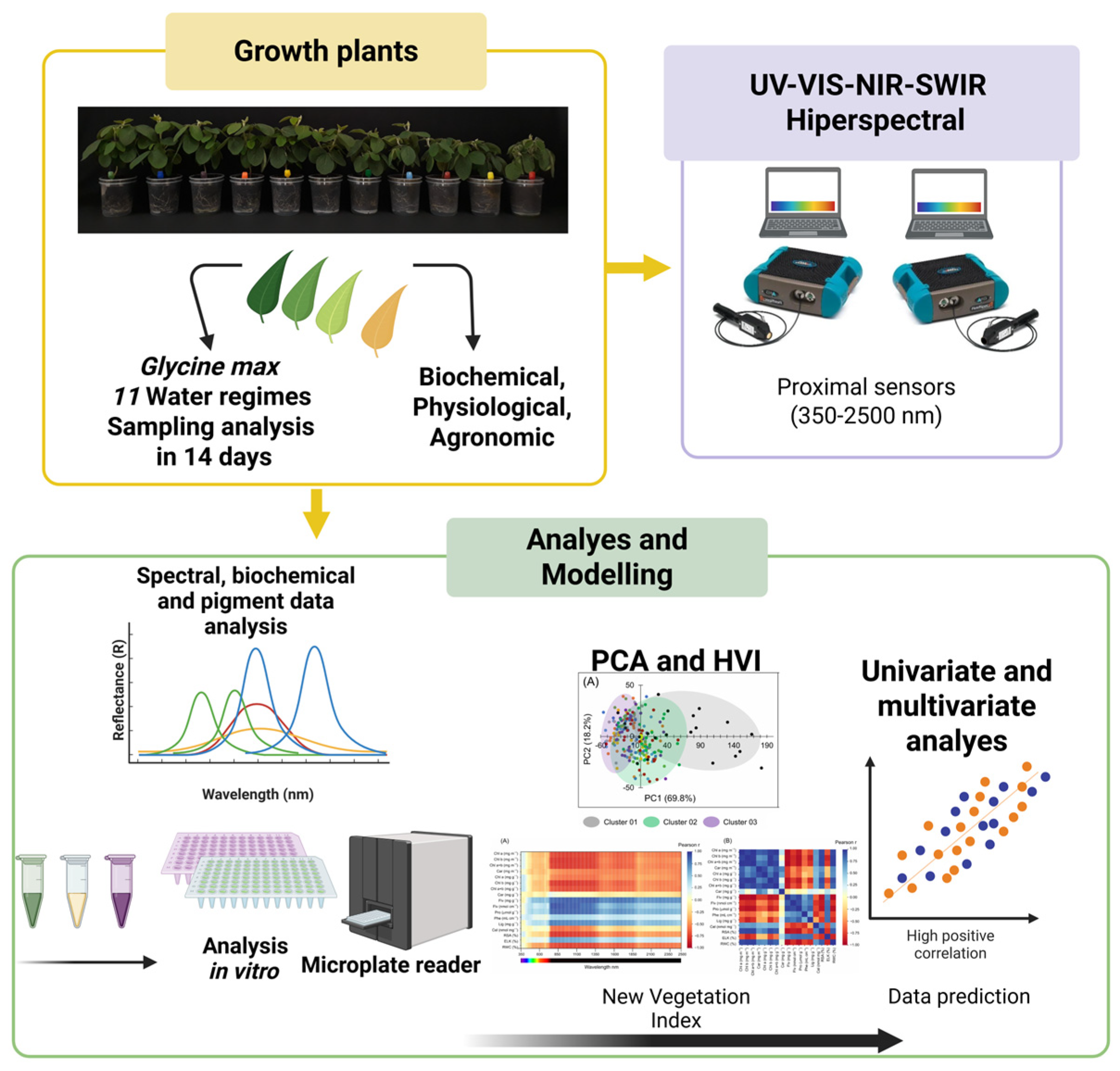
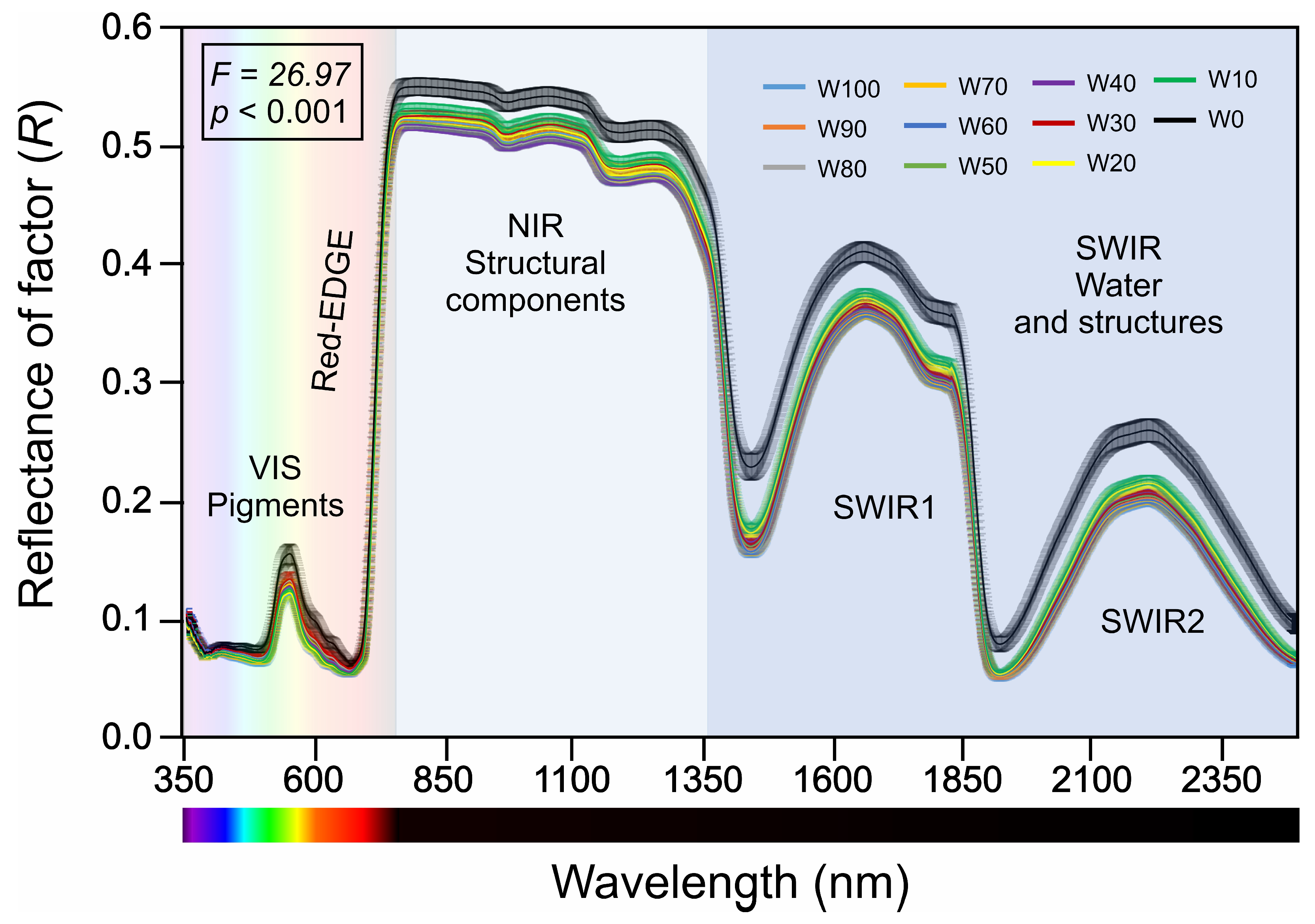


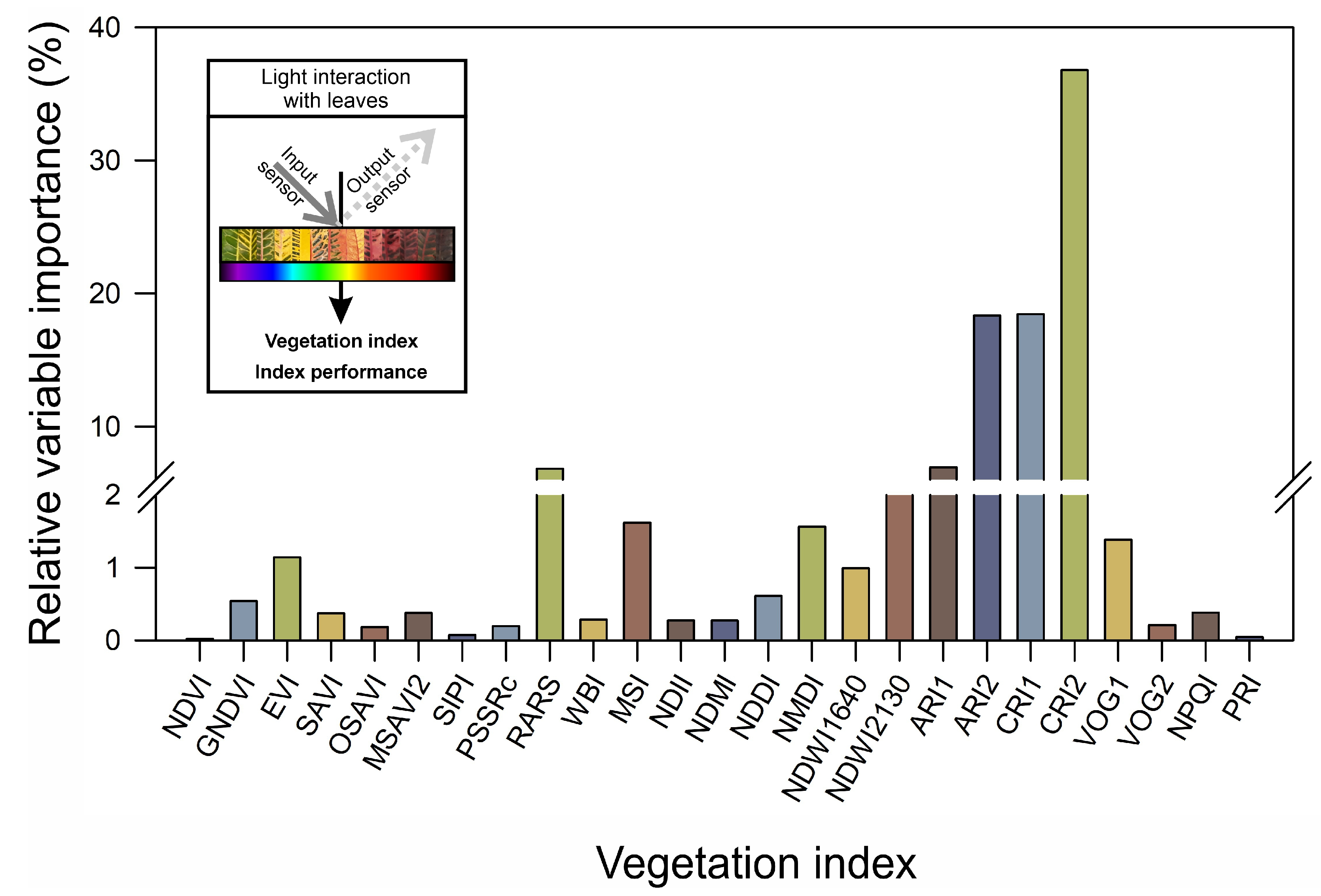

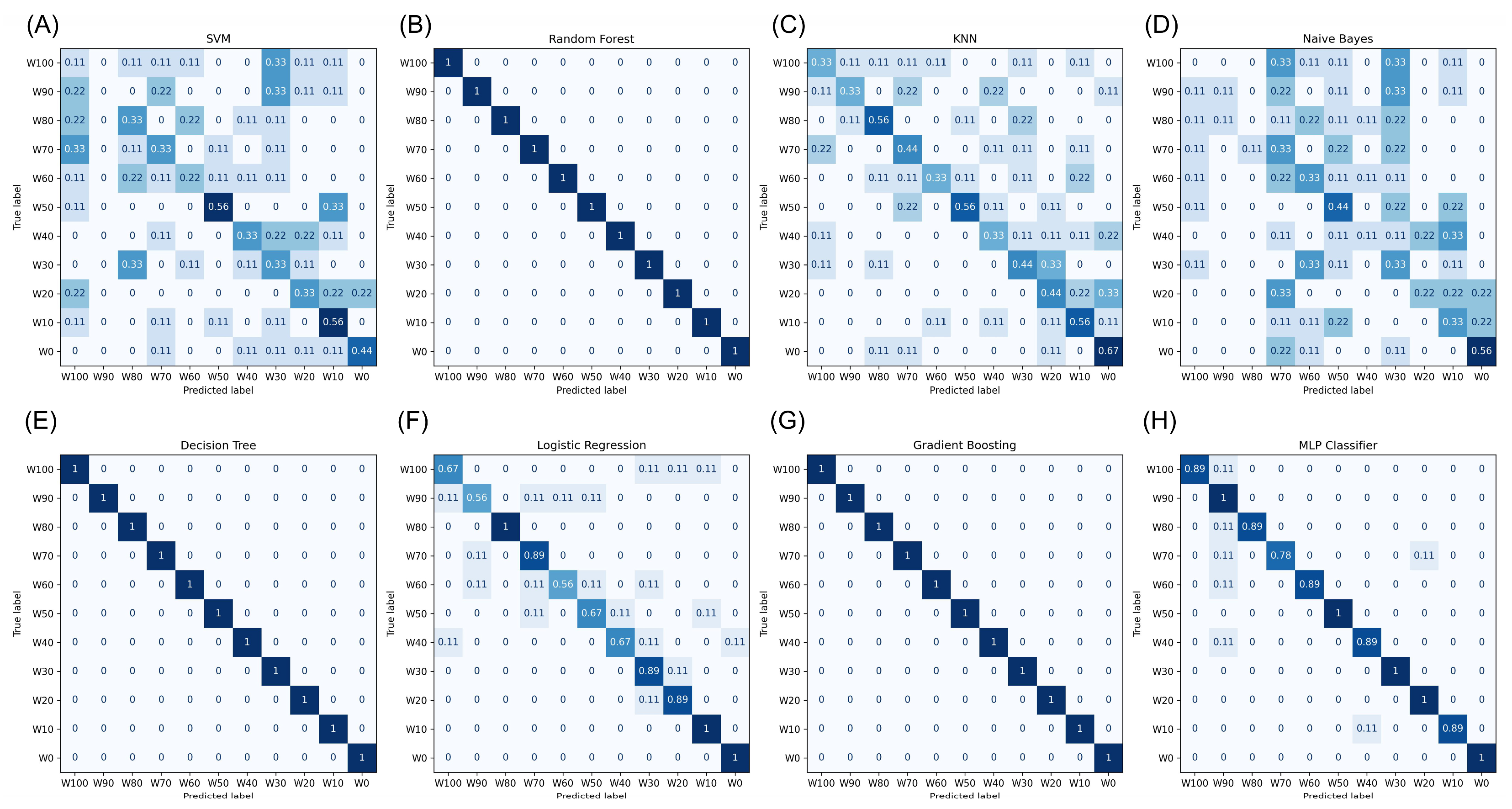
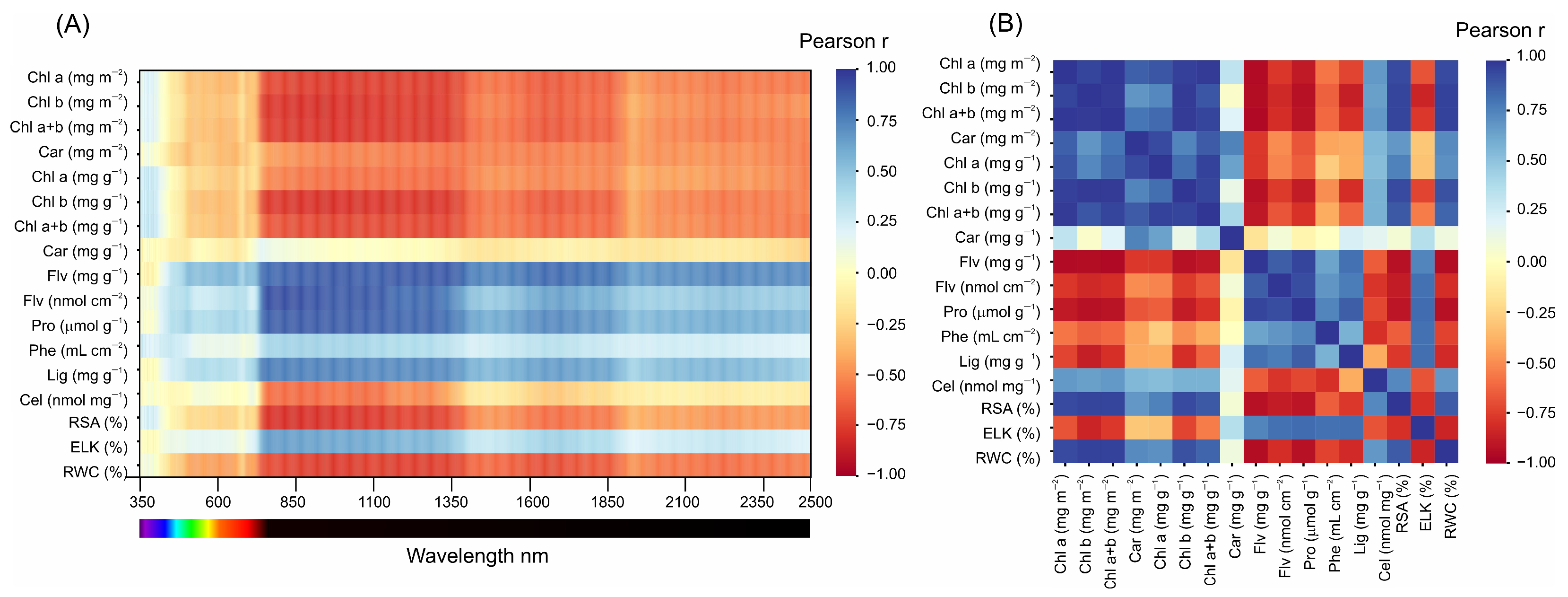
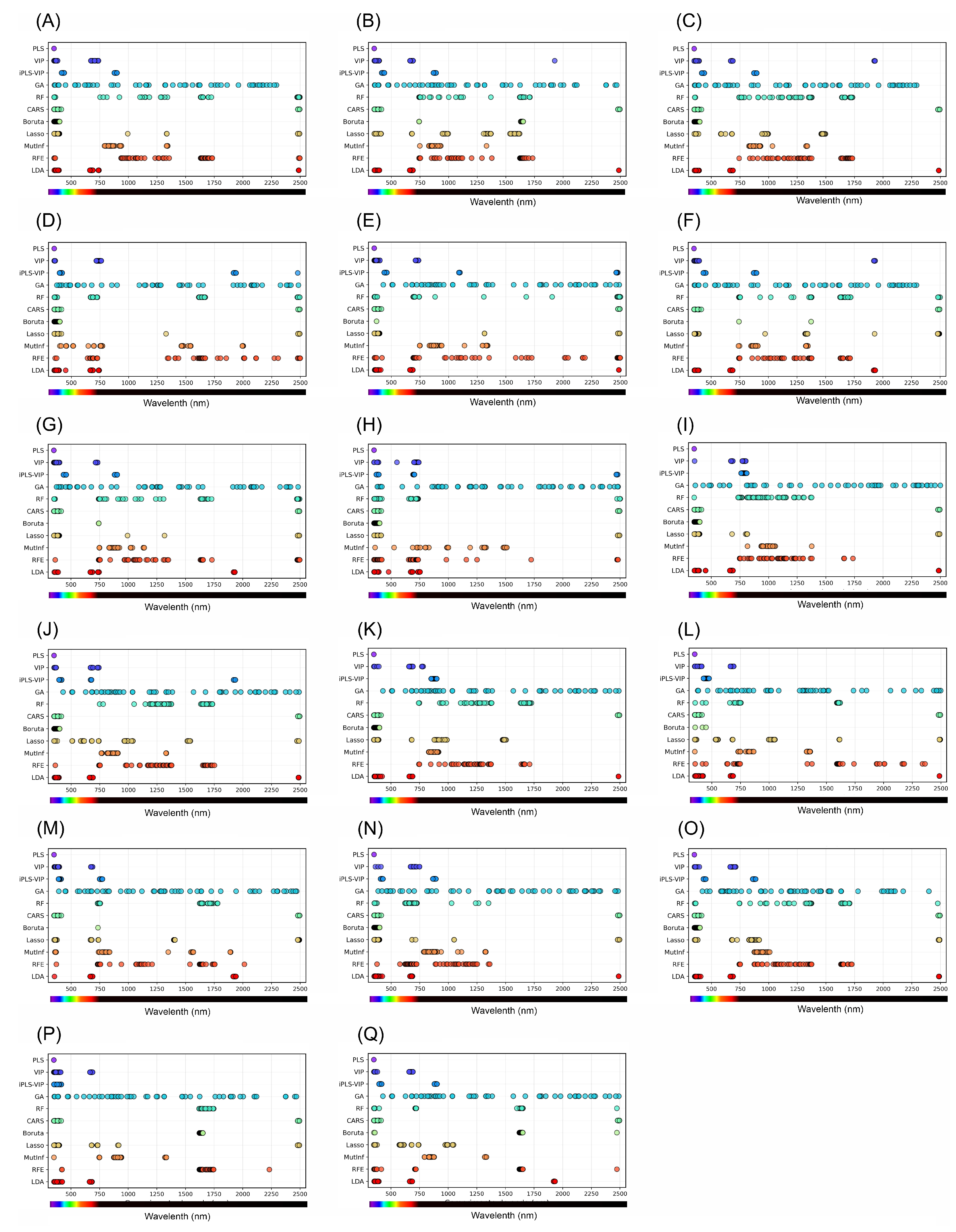
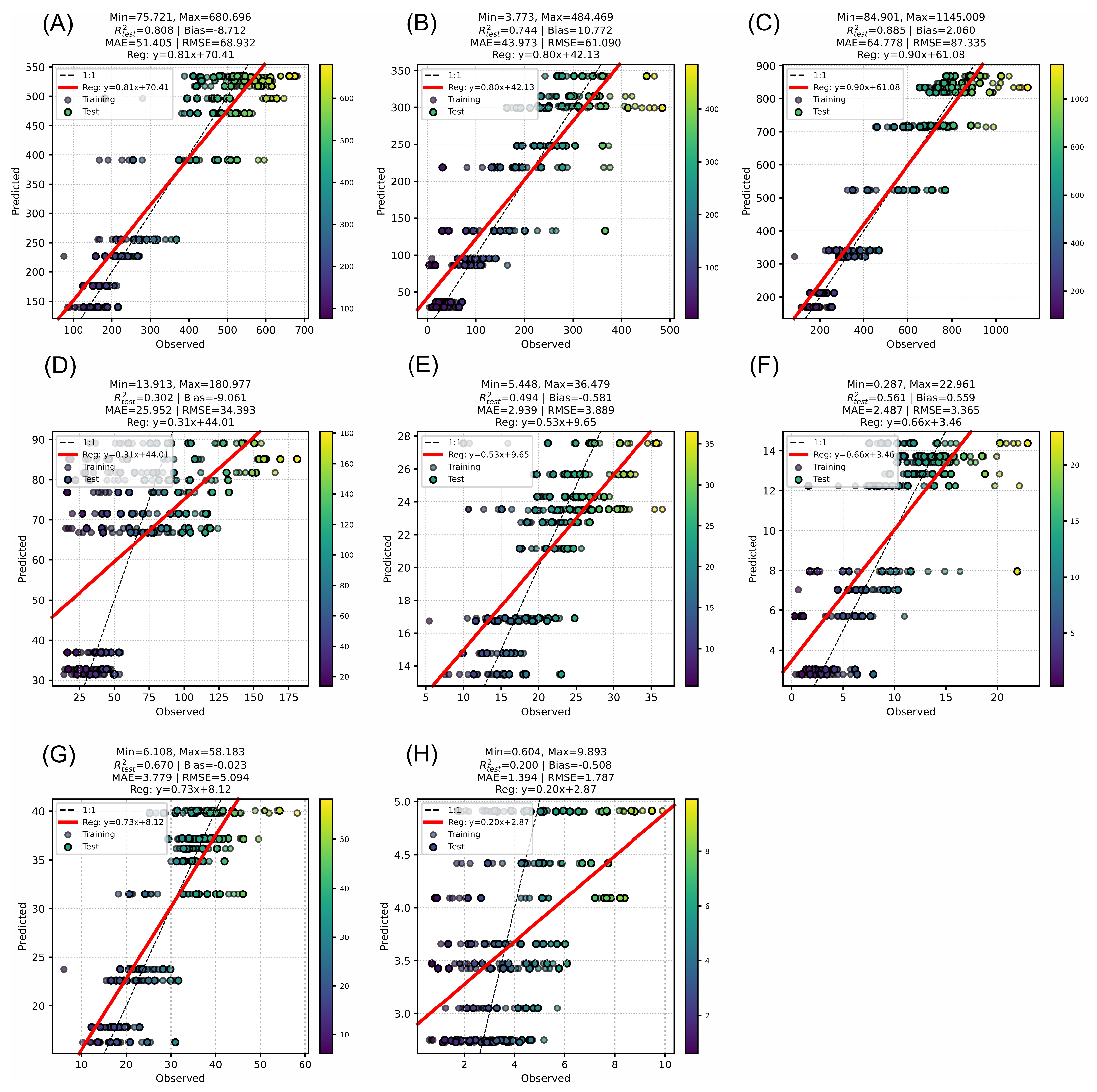
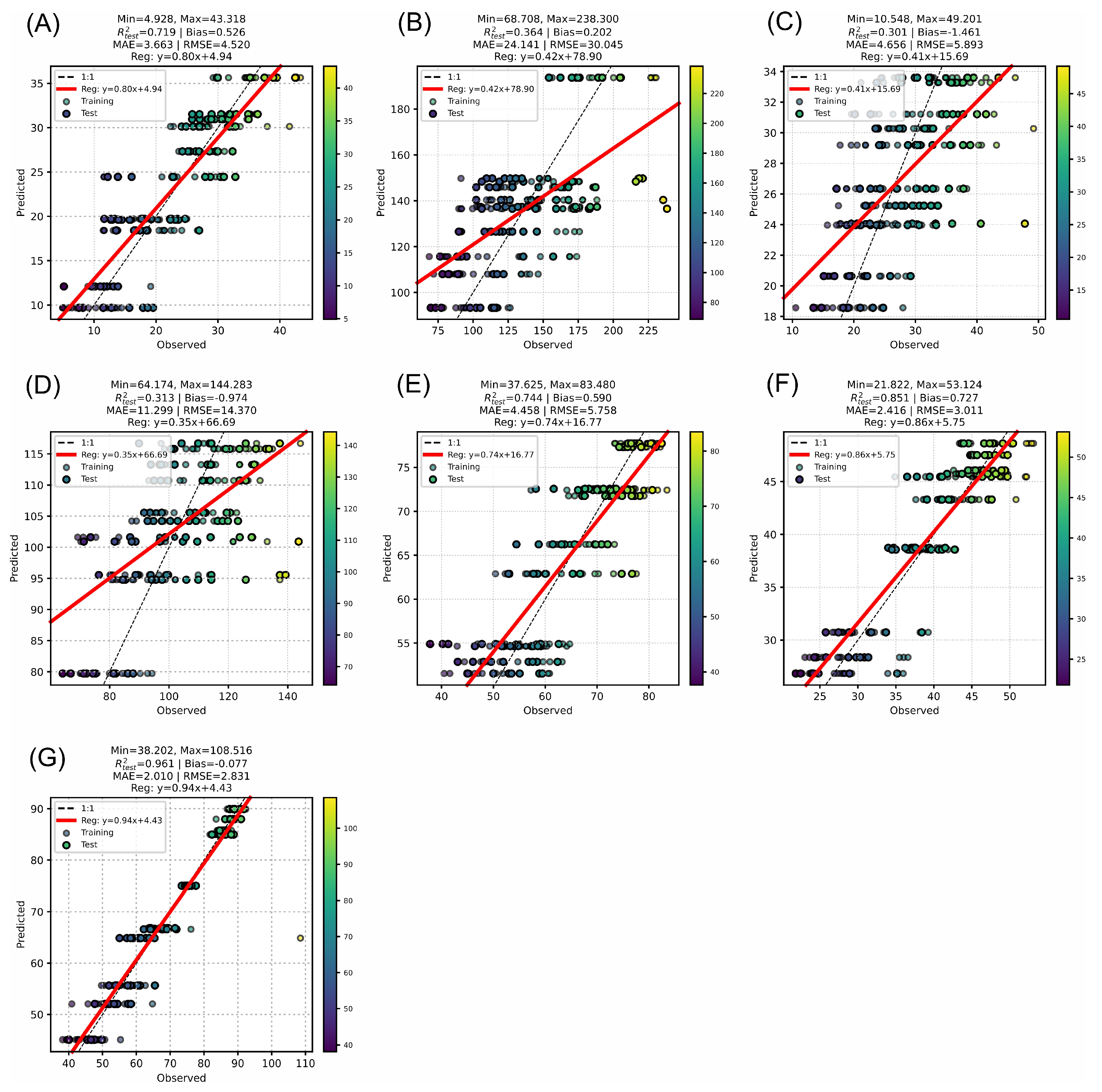
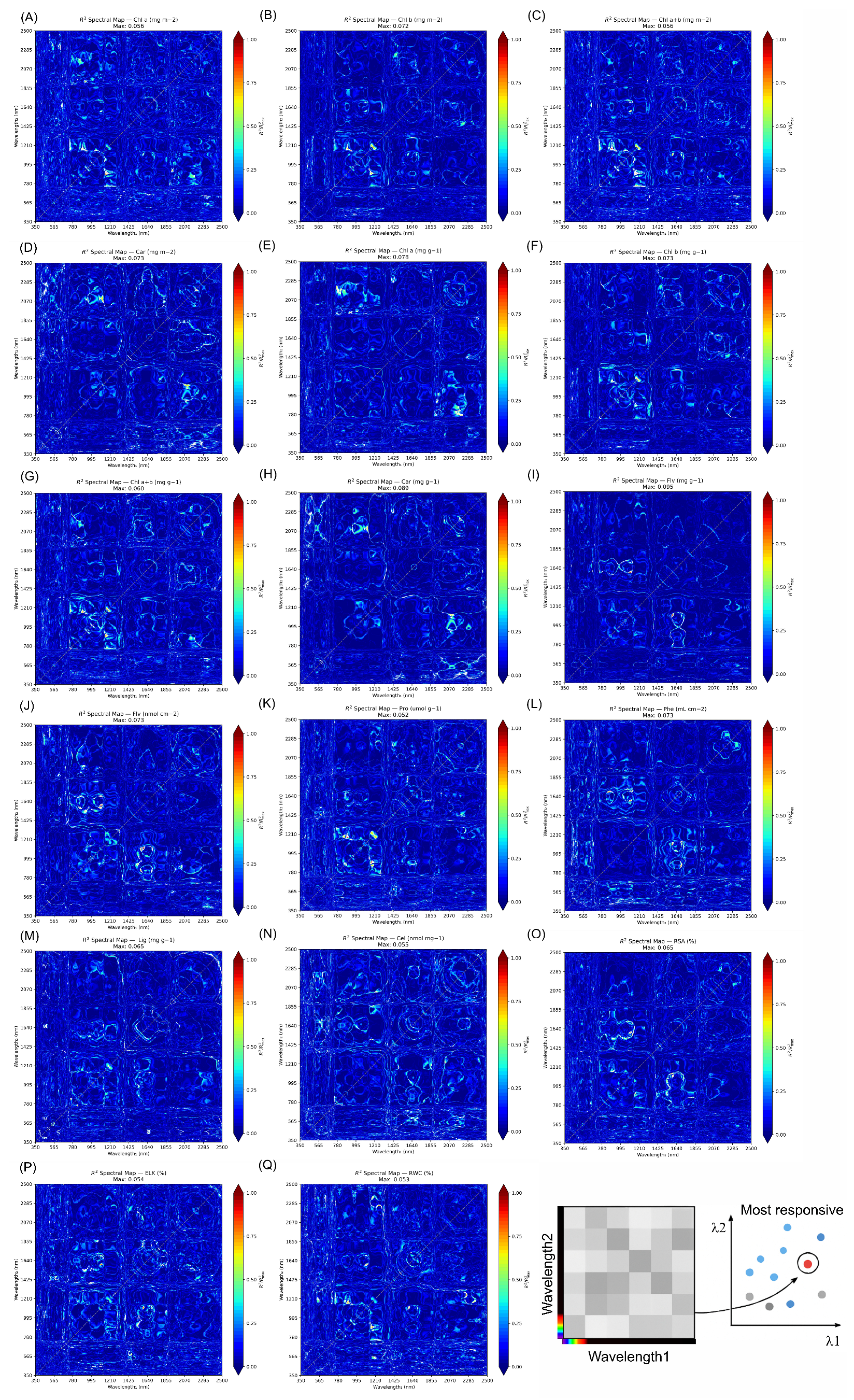
| Vegetation Index | Formula | Reference |
|---|---|---|
| NDVI | [40] | |
| GNDVI | [41] | |
| EVI | [42] | |
| SAVI | [42] | |
| OSAVI | [42] | |
| MSAVI2 | [43] | |
| SIPI | [44] | |
| PSSRc | [44,45] | |
| RARS | [44] | |
| WBI | [46] | |
| MSI | [47] | |
| NDII | [46] | |
| NDMI | [48] | |
| NDDI | [49] | |
| NMDI | [50] | |
| NDWI1640 | [50] | |
| NDWI2130 | [50] | |
| ARI1 | [51] | |
| ARI2 | [51] | |
| CRI1 | [50] | |
| CRI2 | [50] | |
| VOG1 | [52] | |
| VOG2 | [52] | |
| NPQI | [53] | |
| PRI | [54] |
| Physiological Groups | Parameters | Count (n) | Mean | Median | Min | Max | CV (%) |
|---|---|---|---|---|---|---|---|
| Photosynthetic pigments (area) | Chl a (mg m−2) | 264 | 391.51 | 428.75 | 75.72 | 680.70 | 42.29 |
| Chl b (mg m−2) | 264 | 187.01 | 187.92 | 3.77 | 484.47 | 67.05 | |
| Chl a + b (mg m−2) | 264 | 578.52 | 662.99 | 84.90 | 1145.01 | 47.20 | |
| Car (mg m−2) | 264 | 69.10 | 60.53 | 13.91 | 180.98 | 55.78 | |
| Photosynthetic pigments (mass) | Chl a (mg g−1) | 264 | 21.18 | 21.21 | 5.45 | 36.48 | 28.35 |
| Chl b (mg g−1) | 264 | 9.49 | 10.11 | 0.29 | 22.96 | 55.00 | |
| Chl a + b (mg g−1) | 264 | 30.66 | 33.06 | 6.11 | 58.18 | 31.49 | |
| Car (mg g−1) | 264 | 3.86 | 3.56 | 0.60 | 9.89 | 48.95 | |
| Protective compounds | Flv (mg g−1) | 264 | 42.26 | 36.54 | 15.14 | 105.20 | 44.59 |
| Flv (nmol cm−2) | 264 | 67.91 | 67.55 | 37.43 | 109.67 | 22.02 | |
| Pro (umol g−1) | 264 | 23.38 | 24.16 | 4.93 | 43.32 | 37.98 | |
| Phe (mL cm−2) | 264 | 135.88 | 130.45 | 68.71 | 238.30 | 27.93 | |
| Stress markers | Lig (mg g−1) | 264 | 27.53 | 27.11 | 10.55 | 49.20 | 26.63 |
| Cel (nmol mg−1) | 264 | 103.92 | 103.98 | 64.17 | 144.28 | 16.54 | |
| RSA (%) | 264 | 64.75 | 66.38 | 37.62 | 83.48 | 17.39 | |
| ELK (%) | 264 | 39.70 | 41.55 | 21.82 | 53.12 | 20.62 | |
| RWC (%) | 264 | 70.46 | 68.69 | 38.20 | 108.52 | 21.68 |
Disclaimer/Publisher’s Note: The statements, opinions and data contained in all publications are solely those of the individual author(s) and contributor(s) and not of MDPI and/or the editor(s). MDPI and/or the editor(s) disclaim responsibility for any injury to people or property resulting from any ideas, methods, instructions or products referred to in the content. |
© 2025 by the authors. Licensee MDPI, Basel, Switzerland. This article is an open access article distributed under the terms and conditions of the Creative Commons Attribution (CC BY) license (https://creativecommons.org/licenses/by/4.0/).
Share and Cite
Oliveira, C.A.d.; Vedana, N.G.; Mendonça, W.A.; Gonçalves, J.V.F.; Matos, D.H.S.d.; Furlanetto, R.H.; Crusiol, L.G.T.; Reis, A.S.; Antunes, W.C.; Oliveira, R.B.d.; et al. High-Throughput Identification and Prediction of Early Stress Markers in Soybean Under Progressive Water Regimes via Hyperspectral Spectroscopy and Machine Learning. Remote Sens. 2025, 17, 3409. https://doi.org/10.3390/rs17203409
Oliveira CAd, Vedana NG, Mendonça WA, Gonçalves JVF, Matos DHSd, Furlanetto RH, Crusiol LGT, Reis AS, Antunes WC, Oliveira RBd, et al. High-Throughput Identification and Prediction of Early Stress Markers in Soybean Under Progressive Water Regimes via Hyperspectral Spectroscopy and Machine Learning. Remote Sensing. 2025; 17(20):3409. https://doi.org/10.3390/rs17203409
Chicago/Turabian StyleOliveira, Caio Almeida de, Nicole Ghinzelli Vedana, Weslei Augusto Mendonça, João Vitor Ferreira Gonçalves, Dheynne Heyre Silva de Matos, Renato Herrig Furlanetto, Luis Guilherme Teixeira Crusiol, Amanda Silveira Reis, Werner Camargos Antunes, Roney Berti de Oliveira, and et al. 2025. "High-Throughput Identification and Prediction of Early Stress Markers in Soybean Under Progressive Water Regimes via Hyperspectral Spectroscopy and Machine Learning" Remote Sensing 17, no. 20: 3409. https://doi.org/10.3390/rs17203409
APA StyleOliveira, C. A. d., Vedana, N. G., Mendonça, W. A., Gonçalves, J. V. F., Matos, D. H. S. d., Furlanetto, R. H., Crusiol, L. G. T., Reis, A. S., Antunes, W. C., Oliveira, R. B. d., Chicati, M. L., Demattê, J. A. M., Nanni, M. R., & Falcioni, R. (2025). High-Throughput Identification and Prediction of Early Stress Markers in Soybean Under Progressive Water Regimes via Hyperspectral Spectroscopy and Machine Learning. Remote Sensing, 17(20), 3409. https://doi.org/10.3390/rs17203409








